Recipe
GOODNESS
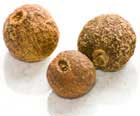 Allspice:
No, this isn't a mixture of everything in your spice rack, but rather a dried berry of the pimenta tree.
If that's a surprise to you, imagine how Columbus felt -- he thought it was pepper (thus the name pimenta,
which is Spanish for pepper). The berries look a little like plump peppercorns and the flavor is pungent,
but it is not pepper. The best allspice comes from Jamaica.
Allspice:
No, this isn't a mixture of everything in your spice rack, but rather a dried berry of the pimenta tree.
If that's a surprise to you, imagine how Columbus felt -- he thought it was pepper (thus the name pimenta,
which is Spanish for pepper). The berries look a little like plump peppercorns and the flavor is pungent,
but it is not pepper. The best allspice comes from Jamaica.For the freshest flavor, you should buy allspice in berry form and grind or crush it as needed. The taste is a pleasant mix of cloves, cinnamon and nutmeg. Used in jerks and for pickling, it goes great with meat and gives a nice kick to soups and stews. |
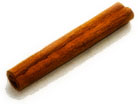 Cinnamon:
Cinnamon comes from the bark of a tropical evergreen, just like its cousin cassia. It has an ancient pedigree,
even being used to embalm a few pharaohs. That may not sound appetizing, but it has been found to be good for the heart,
the stomach and the joints. Not impressed yet? Well consider that it also seems to mimic insulin and therefore helps diabetics moderate their sugar levels. So don't be shy with this tasty and healthy spice.
Cinnamon:
Cinnamon comes from the bark of a tropical evergreen, just like its cousin cassia. It has an ancient pedigree,
even being used to embalm a few pharaohs. That may not sound appetizing, but it has been found to be good for the heart,
the stomach and the joints. Not impressed yet? Well consider that it also seems to mimic insulin and therefore helps diabetics moderate their sugar levels. So don't be shy with this tasty and healthy spice. |
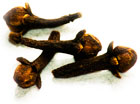 Cloves:
The dried buds of a tropical evergreen, cloves are a wonderful blast of fragrance and flavor.
They were the first known breath fresheners, but have a long, rich history in the spice trades.
These sweet but pungent buds can overwhelm a recipe, so beware!
Cloves:
The dried buds of a tropical evergreen, cloves are a wonderful blast of fragrance and flavor.
They were the first known breath fresheners, but have a long, rich history in the spice trades.
These sweet but pungent buds can overwhelm a recipe, so beware! |
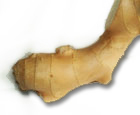 Ginger:
This spicy root is known as the universal remedy. Although it's well-known as a stomach soother, it also improves circulation, fights tumors, reduces inflammation and boosts the immune system. Oh, and it's good for pain and a fever. The only possible drawbacks are for people with gallstones or those on blood thinners.
Ginger:
This spicy root is known as the universal remedy. Although it's well-known as a stomach soother, it also improves circulation, fights tumors, reduces inflammation and boosts the immune system. Oh, and it's good for pain and a fever. The only possible drawbacks are for people with gallstones or those on blood thinners. |
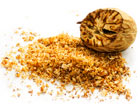 Nutmeg:
What would egg-nog be without nutmeg? But this sweetly aromatic spice is good for much more. As well as flavoring
cakes and fruity desserts, it works wonderfully with strong vegetables like cabbage and cauliflower.
Nutmeg:
What would egg-nog be without nutmeg? But this sweetly aromatic spice is good for much more. As well as flavoring
cakes and fruity desserts, it works wonderfully with strong vegetables like cabbage and cauliflower.Nutmeg quickly loses it's flavor when ground, so get whole kernels and grind them just before using them. The taste is a sweet blend of woody pine and cloves. |
ADVERTISEMENT
Help • Site Map • About Us • Contact Us • Privacy Policy • Press Center
Spice Plan™ Copyright © 2009 by Scott Charles Anderson. All rights reserved.